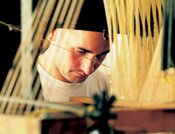Inflight Magazine of Brussels Airlines
Welcome to the Inflight Magazine of Brussels Airlines
Made of silk
Silk is suddenly chic again, but there’s one city where it’s never fallen out of favour. Laura Sharpe unravels the tangled history of Lyon’s silk trade
 From Lanvin’s lavish ruffles and Dries van Noten’s silk-wrapped heels on the spring/summer catwalks this year to Keira Knightley’s recent turn in the eponymous film, it seems that silk is having a moment. And as French fashion houses like Dior and Yves Saint Laurent have shown us, there’s no better place to shop for it than Lyon, silk capital of the world.
From Lanvin’s lavish ruffles and Dries van Noten’s silk-wrapped heels on the spring/summer catwalks this year to Keira Knightley’s recent turn in the eponymous film, it seems that silk is having a moment. And as French fashion houses like Dior and Yves Saint Laurent have shown us, there’s no better place to shop for it than Lyon, silk capital of the world.
Lyon has been shaped by the silk industry in more ways than one. Striated by traboules, covered passageways that were used by workers and merchants to transport silk across town, the city became a Resistance stronghold in World War II. Even today, many regard knowledge of the traboules to be the most effective measure of a ‘true Lyonnais’. Some of the most astonishing scenes in Lyon’s history can be attributed to the industry. It‘s been claimed that both Marxism and trade unionism can trace their roots back to the canuts’ (silk weavers’) activism, and their story still astounds historians like Philibert Varenne, director of local museum-cum-boutique Maison des Canuts.
“What they did is absolutely incredible”, he says. “They owned their own tools and businesses. They could read and write because their profession was so complicated. They created their own newspaper, l’Echo de la Fabrique. They set up the first ever société mutuelle (friendly society) and organised the first structured workers’ revolt in history.”
 Silk production in Lyon stretches back more than 500 years. In 1536, François I declared it France’s main manufacturer, choosing the city because of its magnificent Italian silk markets. For the next 300 years, the canuts lived and worked in the city’s old town, Vieux Lyon, occupying high-ceilinged buildings that could accommodate their immense looms. At the beginning of the 19th century, a new quartier, the Croix Rousse, was built to house them, and it was here that the seeds of industrial unrest were sown.
Silk production in Lyon stretches back more than 500 years. In 1536, François I declared it France’s main manufacturer, choosing the city because of its magnificent Italian silk markets. For the next 300 years, the canuts lived and worked in the city’s old town, Vieux Lyon, occupying high-ceilinged buildings that could accommodate their immense looms. At the beginning of the 19th century, a new quartier, the Croix Rousse, was built to house them, and it was here that the seeds of industrial unrest were sown.
Working between 12 and 14 hours a day, they delivered products to the soyeux (salesmen) who travelled Europe with samples, came back with orders and issued payment. The system worked well for a while, but in 1831, the soyeux reneged on a minimum wage agreement, an incendiary move that instigated massive riots in the city. After three days’ fighting, 150 were left dead and a further 500 were injured. And according to Varenne, it very nearly sparked the country’s second revolution.
“The canuts effectively controlled the city. But they weren’t sure how to use their power. All the elements were there for a revolution, but they didn’t see it through because they weren’t extremists.”
The siege finally ended on 23 November, when King Louis-Philippe deployed 30,000 soldiers to force the canuts to return to their workshops. But the city still aintained a fiercely egalitarian spirit. As England started to turn to mass production, the canuts continued to run around 30,000 small workshops.
 And a residual respect for the city’s weavers is still evident today. Despite the fact that 20th-century industrialisation forced silk weaving into factories outside the city, there are still nine canuts left in three workshops in the Croix Rousse.
And a residual respect for the city’s weavers is still evident today. Despite the fact that 20th-century industrialisation forced silk weaving into factories outside the city, there are still nine canuts left in three workshops in the Croix Rousse.
As Varenne points out: “Lyon has kept these small organisations going. That’s made the difference. In England, there’s hardly any textile production left. In France, the savoir-faire has lasted for over five centuries.”
Ludovic de la Calle , who runs one such organisation, the Soierie Saint-Georges, still uses a Jacquard loom, largely because today’s technology just isn’t up to scratch.
“Despite the rudimentary nature of these looms, they’re the only ones capable of realising what we’re aiming for.’
Similarly, Tassinari et Chatel (a company that dates back to 1680) and Société Prelle (established 1752), who have kept scrupulous archives of original samples and manufacturing methods, were commissioned to restore Louis IV’s bedroom at Versailles. Weaving just 2.7cm a day, it took them 17 years to complete.
And in this age of instant gratification, perhaps it is Lyon’s old-fashioned regard for the slow, painstaking processes of artisan production that has meant the city retained its status as capital of silk. Varenne remains modest. “Some of the most beautiful material in the world has been produced here. And we’re still capable of producing it today”.
How to buy silk
If you’re looking for pure silk, make sure you don’t take home an inferior product…
Contemporary canut Ludovic de la Calle says purchasing silk is like a chemical reaction: “You have to follow your heart. Choosing silk is like choosing jewellery, you need to have a coup de coeur .”
For the best quality-to-price ratio, you should aim to buy directly from the manufacturer. Some manufacturers insist on using only mulberry silk, which is made up of one continuous strand. However, la Calle maintains that wild silk is just as good, giving a more textured finish.
If you’re not sure whether an item is pure silk, try the flame test. Unravel the fabric and burn one end. It should go out after a few millimetres, accompanied by a distinct smell of burning horn. Obviously, this isn’t always a practical option, but you can always ask in the store. Most shopkeepers here are experts in their field.
FR La soie qui a façonné Lyon
La soie est à nouveau chic, en tout cas d’après les jabots plantureux de Lanvin et les talons enrobés de soie de Dries van Noten – et pour se procurer cette matière noble, aucun endroit ne surpasse Lyon, la capitale du monde de la soie. La ville de Lyon a été façonnée par l’industrie de la soie.
La production remonte à plus de 500 ans, et les tenants du Marxisme et du syndicalisme peuvent retrouver les traces de leur engagement dans l’activisme des canuts (ouvriers tisserands) qui a vu l’avènement de la toute première révolte organisée de travailleurs. La ville garde encore cette fierté de la défense de l’esprit égalitaire. Lorsque l’Angleterre s’est tournée vers la production de masse, les canuts ont continué à faire tourner environ 30 000 petits ateliers et aujourd’hui encore, on trouve neuf canuts dans trois ateliers, à la Croix Rousse. Ludovic de la Calle, de la Soierie Saint-Georges, utilise toujours un métier à tisser Jacquard. De même, Tassinari et Chatel (fondé en 1680) et la Société Prelle (fondée en 1752), qui ont gardé les archives des échantillons originaux, des motifs et des méthodes de fabrication, ont été mandatées pour restaurer la chambre à coucher de Louis XIV à Versailles. En tissant 2,7cm par jour, cela leur a pris 17 ans à réaliser. Et dans une époque qui prône la satisfaction immédiate des désirs, le respect de Lyon pour les longs processus de la production artisanale lui préserve son statut vénérable.
Comment acheter
Suivez votre intuition. Choisir de la soie, c’est comme choisir un bijou, vous devez avoir le coup de coeur.
Pour le meilleur rapport qualité/prix, il vaut mieux acheter en direct du fabricant. Certains producteurs utilisent la soie de mure mais la soie sauvage est tout aussi bien, donnant plus de texture à la finition.
En cas de doute pour savoir si un tissu est en pure soie, essayez le test de la flamme. Effilez le tissu et brûlez l’extrémité qui devrait se consumer sur quelques millimètres, avec une odeur très marquée de corne brûlée. Si vous trouvez que ce système n’est pas très facile à appliquer, vous pouvez toujours poser la question dans le magasin.
Where to buy silk
Soierie Saint Georges (11 Rue Mourguet) offers guided tours and has a beautiful shop. It also does custom-made designs.
Maison des Canuts (10-12 Rue d’Ivry) does demonstrations using original machinery and sells regionally produced items.
The Musée des Tissus (34 Rue de la Charité) sells beautiful scarves and stoles.
Tousoie (19 Rue Auguste Comte) stocks products from the Doissin factory and specialises in chiffons and taffeta.
Henri Germain (11 Rue Auguste Comte) is good for furnishings.
André Claude Canova – Soieries de Lyon (26 Quai Saint Vincent) makes exquisitely detailed silk scarves.
Boutique des soyeux lyonnais (20 Rue Romarin) sells a clutch of regional labels.
Les Routes de la Soie (19 Rue Saint-Jean) runs demonstrations of silk hand painting and is appended to a gorgeous boutique.
NL Zijde – de stof die Lyon op de kaart zette
Zijde is weer chic. Denk maar aan Lanvins weelderige ruches en Dries van Notens in zijde gehulde hakkenschoenen. En wie zijde wil kopen, moet naar Lyon – de zijdehoofdstad van de wereld. De geschiedenis van de stad staat volledig in het teken van de zijde-industrie. Zijde wordt er al meer dan 500 jaar vervaardigd, en er wordt zelfs beweerd dat het marxisme en de vakbonden hun oorsprong vinden in de canuts. In Lyon vond trouwens de eerste gestructureerde arbeidersopstand plaats. In de stad waait nog steeds een sterke wind van gelijkheid. Toen Engeland overschakelde naar massaproductie bleven de canuts zowat 30.000 kleine workshops uitbaten. Vandaag zijn er nog negen canuts over in drie workshops in de Croix Rousse. Ludovic de la Calle van de Soierie Saint-Georges gebruikt ook nu nog een jacquardweefgetouw. Tassinari et Chatel (opgericht in 1680) en Société Prelle (opgericht in 1752) beschikken zelfs over archieven van originele stalen, ontwerpen en productiemethodes. Ze kregen dan ook opdracht om de slaapkamper van Lodewijk IV in Versailles te restaureren. Aan een weeftempo van 2,7 cm per dag deden ze er maar liefst 17 jaar over. Maar in tijden waarin alles snel moet gaan, wist Lyon dankzij zijn respect voor trage ambachtelijke productieprocessen toch zijn verheven status te behouden.
Kooptips
Volg je hart. Zijde kopen is als juwelen kiezen. Je moet een coup de coeur hebben.
Voor de beste prijs-kwaliteitverhouding koop je beter rechtstreeks bij de fabrikant. Sommige fabrikanten gebruiken zijde van de moerbeiboom. Maar wilde zijde is net zo goed en heeft een meer gestructureerde afwerking.
Voor wie twijfelt aan de zuiverheid van zijde is er de test met de vlam. Ontrafel de stof en verbrand één uiteinde. Na enkele millimeters moet de vlam uitdoven, gevolgd door een scherpe geur van brandend hoorn. Of je kunt het gewoon in de winkel vragen, natuurlijk.
Leave a Reply
